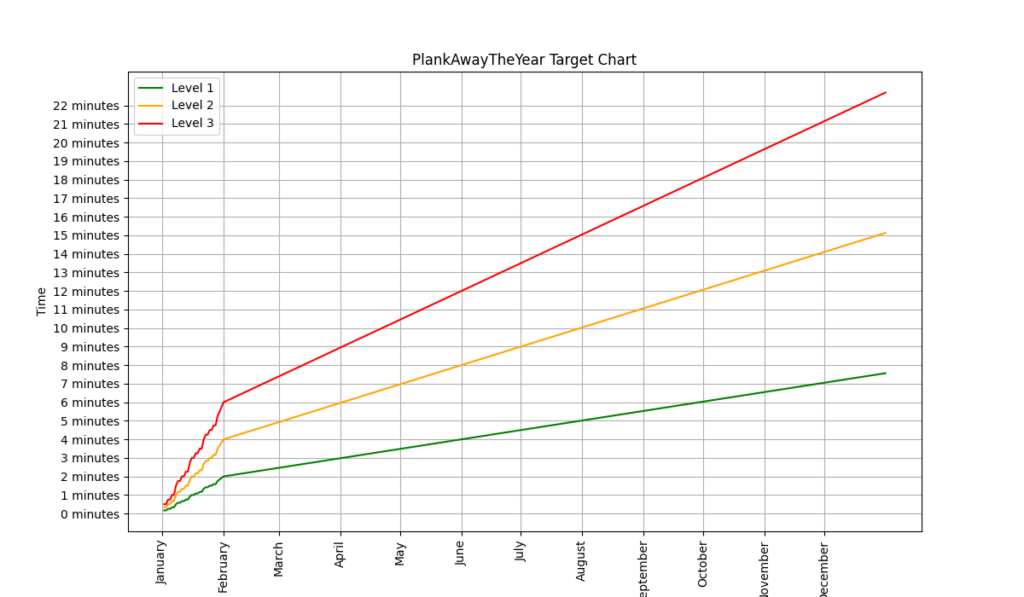Table of Contents
Welcome to the January Plank challenge, a simple yet effective daily challenge that will improve your core strength and endurance throughout the year. It follows on from my January Plank Challenge (PlankAwayJanuary).
Whatever your fitness resolutions for the new year, add this challenge into the mix for daily inspiration and a challenge to keep you focused. This challenge only takes a short time each day; furthermore, my challenges are designed to challenge you and create healthy and active habits that you can continue. You’ll soon learn you don’t need to invest vast amounts of time into exercise; however, you do need to be consistent.
This challenge is staggered & progressively increases in time throughout the year. there are 3 levels to choose from together with three different plank variations.
Are you ready to get your fitness plans for the new year started?
Challenge starts in
[wpdevart_countdown text_for_day=”Days” text_for_hour=”Hours” text_for_minut=”Minutes” text_for_second=”Seconds” countdown_end_type=”date” end_date=”01-01-2024 00:00″ start_time=”1577467066″ end_time=”0,1,1″ action_end_time=”hide” content_position=”center” top_ditance=”10″ bottom_distance=”10″ countdown_type=”button” font_color=”#000000″ button_bg_color=”#3DA8CC” circle_size=”130″ circle_border=”5″ border_radius=”8″ font_size=”30″ countdown_font_famaly=”monospace” animation_type=””]This challenge has already started.[/wpdevart_countdown]Want a shorter Plank Challenge?
Get started today with the 28 Day Plank Challenge.
What is a plank
The plank is an excellent isometric exercise, it requires core stabilizers to fire to maintain body & spinal alignment. A staple of fitness and is often used during fitness tests and assessments.
Often also referred to as a prone bridge it is a simple static exercise that will work every part of your core and your whole body as you maintain a rigid position.
Visually the plank is a bridge supported on your toes and forearms, a straight line from your heels to your shoulders. As a result, It looks so simple that you’d think it was easy, but it is not. Consequently, you’ll find the plank in almost any fitness programme and that is because it is highly effective and works a fundamental muscle group, your core.


5 Reasons to Plank every day
Scoring the Plank Challenge
The challenge is split into 3 levels for which you can score your progress, you don’t need to keep to one level, You can mix & match and go up or down a level. Each level has a score associated with it, use the free-scoring sheet available for download below to track your progress and tally your total score for the month
| TARGET LEVEL | POINTS | EXERCISE LEVEL | POINTS |
| Level 1 | 1 point | Easy (Half Plank) | + 1 point |
| Level 2 | 2 points | Moderate (Full Blank) | + 2 points |
| Level 3 | 3 points | Advanced (UP/Downs) | + 3 points |
Plank Challenge Target Guide
Plank Away The Year Scoring Sheet (Yearly Plank Challenge) 169.50 KB 193 downloads
Scoring sheet for the yearly plank challenge which follows on from the January Plank…Suggested Equipment
- GymBoss (sponsored link via Amazon.co.uk)
- Exercise Matt (sponsored link via Amazon.co.uk)
GymBoss, the Number One Tool you Need to Time your HIIT Intervals
Programme Design
This yearly plank challenge is a daily challenge to perform a plank or a set of planks every day throughout the year. No easy task (well, it is a challenge).
The yearly plank challenge follows on from the January Plank Challenge and slower escalates in total time. The total time is divided by the number of months you are in to give you the number of sets you will perform that month. e.g in February, you will perform 2 sets and in March 3 sets and so on.
There are 3 levels. however, you can mix and match, use the scoring sheet to get your target and score your challenge using the scoring guide above.

The Plank Exercise
There are 3 variations of the plank designed for the beginner, intermediate and advanced levels of fitness.
- Beginner – Half Plank
- Intermediate – Forearm or Straight Arm Plank
- Advanced – Plank Up Downs
Want more? Check out my 28 Plank Variations
The plank is a type of bodyweight exercise that helps to strengthen the core muscles, including the abs, obliques, and back muscles. It is typically performed by holding a plank position for a period of time, with the body supported by the forearms or hands and the toes.
There are three variations of the plank that are designed for different fitness levels:
- Beginner – Half Plank: This variation is suitable for those who are new to planking or have low levels of core strength. To perform the half plank, start in a plank position with your forearms on the ground and your feet shoulder-width apart. Engage your core muscles and hold this position for as long as you can, working up to longer periods of time as you get stronger.
- Intermediate – Forearm or Straight Arm Plank: This variation is more challenging than the half plank, as it requires more core strength to maintain proper form. To perform a forearm plank, start in a plank position with your forearms on the ground and your feet shoulder-width apart. Engage your core muscles and hold this position for as long as you can, working up to longer periods of time as you get stronger. To perform a straight arm plank, start in a plank position with your hands on the ground and your feet shoulder-width apart. Engage your core muscles and hold this position for as long as you can, working up to longer periods of time as you get stronger.
- Advanced – Plank-Up Downs: This variation is the most challenging of the three, and is suitable for those with high levels of core strength. To perform plank up-downs, start in a forearm plank position with your forearms on the ground and your feet shoulder-width apart. Engage your core muscles and lift one arm off the ground to the straight arm plank position followed by the other arm and then return to the forearm plank position. Continue to alternate between hands.
It’s important to keep proper form when performing any variation of the plank. Keep your body straight and your core engaged, and make sure that your shoulders, hips, and heels are aligned. Avoid sagging or arching your back, and take breaks as needed to rest and avoid fatigue.
Key Points
- Keep neutral spine alignment
- Maintain a straight line through shoulders, hips, knees & ankles
- Maintain abdominal tension
- Remember to breath
Beginner – Half Plank (from knees)
The half plank from the knees is a beginner-level variation of the traditional plank exercise that is great for those who are new to planking or who have limited upper body strength. To perform a half plank from the knees, start by positioning yourself on the ground in a push-up position with your hands or forearms placed shoulder-width apart and your knees on the ground. Keep your body straight and engage your core muscles as you hold this position for a set amount of time. It’s important to keep your body in a straight line and avoid sinking into your shoulders or arching your back.
Regular – Forearm Plank or Straight Arm Plank
The forearm or straight arm plank is the traditional plank exercise that focuses on strengthening the core, back, and shoulder muscles. To perform a forearm plank, start by positioning yourself on the ground in a push-up position with your forearms on the ground and your elbows bent at a 90-degree angle or with straight arms on your hands. Keep your body straight and engage your core muscles as you hold this position for a set amount of time. It’s important to keep your body in a straight line and avoid sinking into your shoulders or arching your back.
Plank Up Downs
This challenge is completely Free
If you enjoyed this challenge, you can support my work by buying me a coffee.




